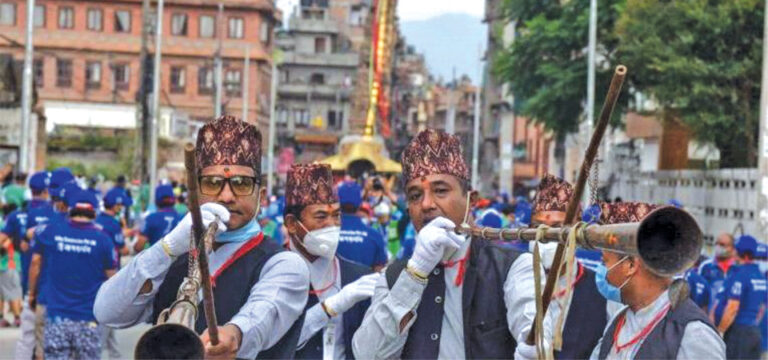
Preeti Byanjankar
Nepal has been popular around the world for its unique culture and tradition since ancient times. The culture and tradition here differ from one part to another. The temple of gods and goddesses, culture, tradition, and festivals give Nepal a special place.
The Kathmandu Valley and its Newari culture are rich in songs and musical instruments. Here, songs are sung and musical instruments are played as per seasons, days and events. Nepal has around 1000 musical instruments and 56 of them are played only by the Newars.
Among those instruments, many of them have already become extinct. Some of them are not in practice anymore. Some musical instruments need little more attention for their preservation and to keep them in practice. Indra Baja (Kaa: Baja) is also one of them.
Indra Baja is played during the time of birth and death as well. This instrument is also played during many festivals. This instrument is considered an ancient one and is played based on weave and precept.
Played During Festivals
Kaa: Baja has three parts which are made up of copper and are played by blowing its tip. This instrument is also played in the festival of Rato Machhindranath (chariot pulling), which is the longest festival in the world. The chariot pulling of Rato Machhindranath takes place in Lalitpur in the month of Baisakh.
Indra Baja is also played in other festivals like Khadak Jatra (Payo Jatra). It is also played in several events. Like, while going to take the soul of God Rato Machhindra Nath, Bhoto Jatra, Kumari Jatra, and so on. In the Newari culture, Indra Baja is mandatory while burning the dead body.
Playing this instrument, it is believed, overcomes all bad luck and spreads the good charm. Moreover, it is played by the community people like Tepe, Jyapu and Khusa from Lalitpur. These people play it in the various events that happen at the Pashupati temple.
Bala Chaturdashi is one of the important festivals that take place in the Pashupati temple area. In this festival, many devotees observe fasting for the whole night and in the morning sow seven types of grains around forests and open spaces of the Pashupati area for the salvation of their ancestors. During the Bala Chaturdasi festival, the Newar community people go to Pashupati playing Indra Baja.
They play the Baja with different musical notes according to the events. This instrument is played in three different musical notes. It is believed that the sound of this instrument reaches up to Lord Indra in heaven which will force him to open the door of heaven for the dead people.
The playing of Indra Baja (Kaa: Baja) is taught once every 10-12 years. It takes around 3-6 months to learn. Before starting learning, the learners should contribute rice with a coin and areca nut to God by putting it in small Palcha. A good day to start learning is on Thursday.
The playing of this instrument is taught in two ways. That is “Bahaya” and “Guhaya”. The tones that are played in festivals are taught in theories (note) and practice. But the tone which is played in the death rituals is practised only by reading or writing method. Since that tone is restricted to play on any other events except for during death rituals.
Likewise, the ending of training of playing this instrument is done by playing it at a temple.
Every individual should play a necessary role to protect the culture. It is necessary to preserve these historical instruments. A long time ago, Indra Baja used to be a part of Newari Guthi and had around 7-10 members. Later around 2065/66, to preserve the tradition of playing this instrument, the community people established it as a “Kaa: Manka Guthi (Indra Baja)”. On Ashad 11, 2066 the Indra Baja Guthi is officially registered at Nepal Government. Since then, the Guthi follows all the required processes such as renewing, making income and expenditure statements public. By 2078, Indra Baja Guthi had 50 members. The step of registering Indra Baja Guthi officially was a good step for the preservation of the tradition of Baja playing. This way it can be preserved and handed over from one generation to another generation. The youths are encouraged to learn how to play Indra Baja.
Furthermore, the team performed Indra Baja playing even during COVID-19. While the Rato Machhindranath chariot was pulled during the pandemic taking the necessary precautions, the Indra Baja team was also present there. The members played their roles while pulling the chariot. They performed following government rules on health safety protocols.
Preservation
The young generation must be effortful to the preservation of their culture and tradition. Respecting and preserving cultures does not make us conservative. Our culture and heritage make all of us proud because Nepal has a unique way to celebrate festivals and traditions. In addition, living in a dynamic world makes our life interesting. Cultural preservation is necessary as it preserves the belongings of a specific community. Meanwhile, sharing and learning about our tradition and culture from our senior citizens is the best way to preserve them for other generations.
(TRN)






